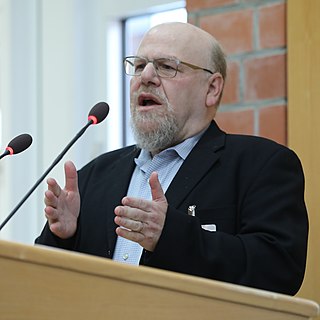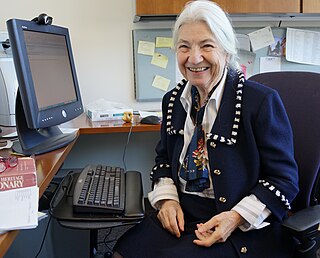Related Research Articles

Dabbala Rajagopal "Raj" Reddy is an Indian-born American computer scientist and a winner of the Turing Award. He is one of the early pioneers of artificial intelligence and has served on the faculty of Stanford and Carnegie Mellon for over 50 years. He was the founding director of the Robotics Institute at Carnegie Mellon University. He was instrumental in helping to create Rajiv Gandhi University of Knowledge Technologies in India, to cater to the educational needs of the low-income, gifted, rural youth. He is the chairman of International Institute of Information Technology, Hyderabad. He is the first person of Asian origin to receive the Turing Award, in 1994, known as the Nobel Prize of Computer Science, for his work in the field of artificial intelligence.

Judea Pearl is an Israeli-American computer scientist and philosopher, best known for championing the probabilistic approach to artificial intelligence and the development of Bayesian networks. He is also credited for developing a theory of causal and counterfactual inference based on structural models. In 2011, the Association for Computing Machinery (ACM) awarded Pearl with the Turing Award, the highest distinction in computer science, "for fundamental contributions to artificial intelligence through the development of a calculus for probabilistic and causal reasoning". He is the author of several books, including the technical Causality: Models, Reasoning and Inference, and The Book of Why, a book on causality aimed at the general public.

James Alexander Hendler is an artificial intelligence researcher at Rensselaer Polytechnic Institute, United States, and one of the originators of the Semantic Web. He is a Fellow of the National Academy of Public Administration.
Ekaterini Panagiotou Sycara is a Greek computer scientist. She is an Edward Fredkin Research Professor of Robotics in the Robotics Institute, School of Computer Science at Carnegie Mellon University internationally known for her research in artificial intelligence, particularly in the fields of negotiation, autonomous agents and multi-agent systems. She directs the Advanced Agent-Robotics Technology Lab at Robotics Institute, Carnegie Mellon University. She also serves as academic advisor for PhD students at both Robotics Institute and Tepper School of Business.

Ayanna MacCalla Howard is an American roboticist, entrepreneur and educator currently serving as the dean of the College of Engineering at Ohio State University. Assuming the post in March 2021, Howard became the first woman to lead the Ohio State College of Engineering.

Manuela Maria Veloso is the Head of J.P. Morgan AI Research & Herbert A. Simon University Professor in the School of Computer Science at Carnegie Mellon University, where she was previously Head of the Machine Learning Department. She served as president of Association for the Advancement of Artificial Intelligence (AAAI) until 2014, and the co-founder and a Past President of the RoboCup Federation. She is a fellow of AAAI, Institute of Electrical and Electronics Engineers (IEEE), American Association for the Advancement of Science (AAAS), and Association for Computing Machinery (ACM). She is an international expert in artificial intelligence and robotics.

Ruzena Bajcsy is an American engineer and computer scientist who specializes in robotics. She is professor of electrical engineering and computer science at the University of California, Berkeley, where she is also director emerita of CITRIS.
Lydia E. Kavraki is a Greek-American computer scientist, the Noah Harding Professor of Computer Science, a professor of bioengineering, electrical and computer engineering, and mechanical engineering at Rice University. She is also the director of the Ken Kennedy Institute at Rice University. She is known for her work on robotics/AI and bioinformatics/computational biology and in particular for the probabilistic roadmap method for robot motion planning and biomolecular configuration analysis.
Margaret Martonosi is an American computer scientist who is currently the Hugh Trumbull Adams '35 Professor of Computer Science at Princeton University. Martonosi is noted for her research in computer architecture and mobile computing with a particular focus on power-efficiency.
Nancy Marie Amato is an American computer scientist noted for her research on the algorithmic foundations of motion planning, computational biology, computational geometry and parallel computing. Amato is the Abel Bliss Professor of Engineering and Head of the Department of Computer Science at the University of Illinois at Urbana-Champaign. Amato is noted for her leadership in broadening participation in computing, and is currently a member of the steering committee of CRA-WP, of which she has been a member of the board since 2000.
Julia Hirschberg is an American computer scientist noted for her research on computational linguistics and natural language processing.
Henry A. Kautz is a computer scientist, Founding Director of Institute for Data Science and Professor at University of Rochester. He is interested in knowledge representation, artificial intelligence, data science and pervasive computing.

ACM SIGAI is the Association for Computing Machinery's Special Interest Group on Artificial Intelligence (AI), an interdisciplinary group of academic and industrial researchers, practitioners, software developers, end users, and students who work together to promote and support the growth and application of AI principles and techniques throughout computing. SIGAI is one of the oldest special interest groups in the ACM. SIGAI, previously called SIGART, started in 1966, publishing the SIGART Newsletter that later became the SIGART Bulletin and Intelligence Magazine.
Robin Roberson Murphy is an American computer scientist and roboticist. She is the Raytheon Professor of Computer Science and Engineering at Texas A&M University. She is known as a founder of the fields of rescue robotics and human-robot interaction and for inserting robots into disasters. Her case studies of how unmanned systems under perform in the field led cognitive systems engineering researcher David Woods to pose the (Robin) Murphy's Law of Autonomy: a deployment of robotic systems will fall short of the target level of autonomy, creating or exacerbating a shortfall in mechanisms for coordination with human problem holders. Her TED talk “These Robots Come to the Rescue After a Disaster” was listed in TED Talks: The Official TED Guide to Public Speaking as one of the examples of a good TED talk. Murphy is also known for using science fiction as an innovative method of teaching artificial intelligence and robotics.

Marie desJardins is an American computer scientist, known for her research on artificial intelligence and computer science education. She is also active in broadening participation in computing.
Yolanda Gil is a Spanish computer scientist specializing in knowledge discovery and knowledge-based systems at the University of Southern California (USC). She served as chair of SIGAI the Association for Computing Machinery (ACM) Special Interest Group (SIG) on Artificial Intelligence, and the president of the Association for the Advancement of Artificial Intelligence (AAAI).

Pearl Pu is a Chinese-born Swiss computer scientist. After completing her Ph.D. from the University of Pennsylvania, she obtained the Research Initiation Award from NSF before moving to Switzerland. She has been a faculty member and senior scientist at École Polytechnique Fédérale de Lausanne, where she founded the Human-Computer Interaction Group in 2000. In 1997, she co-founded the company, Iconomic Systems SA, known for the development of an agent-based paradigm for travel e-commerce and was chairperson until its sale to i:FAO in 2001. She spent 6 months each as visiting scholar at Stanford University in 2001 and at the Hong Kong University of Science and Technology in 2010.
Sheila McIlraith is a Canadian computer scientist specializing in Artificial Intelligence (AI). She is a Professor in the Department of Computer Science, University of Toronto, Canada CIFAR AI Chair, and Associate Director and Research Lead of the Schwartz Reisman Institute for Technology and Society.
Lynne Edwards Parker is Associate Vice Chancellor and Director of the AI Tennessee Initiative at the University of Tennessee. Previously, she was Deputy United States Chief Technology Officer and Founding Director of the National Artificial Intelligence Initiative Office at the United States' White House Office of Science and Technology Policy. She is an American roboticist specializing in multi-robot systems, swarm robotics, and distributed artificial intelligence.
Shashi Shekhar is a leading scholar of spatial computing, spatial data science, and Geographic Information Systems (GIS). Contributions include scalable roadmap storage methods and algorithms for eco-routing, evacuation route planning, and spatial pattern mining, along with an Encyclopedia of GIS, a Spatial Databases textbook, and a spatial computing book for professionals. Currently, he is serving as a McKnight Distinguished University Professor, a Distinguished University Teaching Professor, ADC Chair and an Associate Director of the College of Science and Engineering Data Science Initiative at the University of Minnesota.
References
- 1 2 "Maria Gini".
- ↑ "CRA-W Board".
- 1 2 Pattison, Kermit. "Maria Gini: Encountering imbalance". University of Minnesota - College of Science and Engineering.
- ↑ University of Minnesota (2016-07-01). "Faculty profile: Maria L. Gini". twin-cities.umn.edu. Archived from the original on 2020-01-22. Retrieved 2020-03-06.
- 1 2 "University-wide awards for teaching, advising and service".
- ↑ "Elected AAAI Fellows".
- ↑ "IEEE Fellows Directory".
- 1 2 "CRA-W Board Member Maria Gini Receives 2019 CRA A. Nico Habermann Award". Computing Research Association - Women.
- ↑ "MinneWIC - News". 8 April 2020.
- ↑ "Summer Computing Academy for female students (junior high and high school)".
- ↑ Giuseppina Gini & Maria Gini (1985). "Dealing with World Model Based Languages". ACM Transactions on Programming Languages and Systems. 7 (2): 334–347. CiteSeerX 10.1.1.577.5919 . doi:10.1145/3318.3479. S2CID 17339367.
- ↑ Duane Olawsky & Maria Gini (1990). "Deferred Planning and Sensor Use". Proceedings of the 1990 DARPA Workshop on Innovative Approaches to Planning, Scheduling and Control. Morgan Kaufmann: 166–174.
- ↑ Maksim Tsvetovat; Maria Gini; Bamshad Mobasher & Zbigniew Wieckowski (1997). "MAGMA: An Agent-Based Virtual Market for Electronic Commerce". Journal of Applied Artificial Intelligence. 11 (6): 501–524. CiteSeerX 10.1.1.56.9321 . doi:10.1080/088395197118046. S2CID 9511735.
- ↑ Paul E. Rybski; Sascha A. Stoeter; Maria Gini; Dean F. Hougen & Nikolaos Papanikolopoulos (2002). "Performance of a Distributed Robotic System Using Shared Communications Channels" (PDF). IEEE Transactions on Robotics and Automation. 22 (5): 713–727. Bibcode:2001SPIE.4571...84R. CiteSeerX 10.1.1.59.1964 . doi:10.1117/12.444149. S2CID 110549154.
- ↑ Francesco Amigoni; Simone Gasparini & Maria Gini (2006). "Building Segment-Based Maps without Pose Information". Proceedings of the IEEE. 94 (7): 1340–1359. CiteSeerX 10.1.1.294.6845 . doi:10.1109/JPROC.2006.876925. S2CID 6986046.
- ↑ Maitreyi Nanjanath & Maria Gini (2010). "Repeated auctions for robust task execution by a robot team". Robotics and Autonomous Systems. 58 (7): 900–909. CiteSeerX 10.1.1.226.4841 . doi:10.1016/j.robot.2010.03.011. S2CID 2304288.
- ↑ Wolfgang Ketter; John Collins; Maria Gini; Alok Gupta & Paul Schrater (2012). "Real-time Tactical and Strategic Sales Management for Intelligent Agents Guided By Economic Regimes". Information Systems Research. 23 (4): 1263–1283. doi:10.1287/isre.1110.0415. hdl: 1765/32838 . S2CID 2810884.
- ↑ 2019 ACM Fellows Recognized for Far-Reaching Accomplishments that Define the Digital Age, Association for Computing Machinery, retrieved 2019-12-11
- ↑ Galik, Angela (May 1, 2018). "Dr. Maria Gini Announced as the 2018 NCWIT Harrold and Notkin Award Recipient". NCWIT.
- ↑ "2018 IEEE RAS Fellow Class Announced - IEEE Robotics and Automation Society". www.ieee-ras.org. Retrieved 2020-03-06.
- ↑ "Maria Gini". www-users.cs.umn.edu. Retrieved 2020-03-06.
- ↑ "25 women in robotics you need to know about (2014) | Robohub" . Retrieved 2020-03-06.
- ↑ INFORMS Information Systems Society (ISS). "INFORMS ISS Design Science Award". informs.org. Archived from the original on 2016-03-03. Retrieved 2015-06-03.
- ↑ Association for Advancement of Artificial Intelligence. "Current AAAI members who are fellows". AAAI. Retrieved 2015-05-31.
- ↑ Association for Computing Machinery. "Awards ACM Distinguished Member Maria L. Gini". ACM. Retrieved 2015-05-31.
- ↑ "University of Minnesota Scholar's Walk".
- ↑ "Distributed Robotics". www-users.cs.umn.edu. Retrieved 2020-03-06.
- ↑ "MinERS: Minnesota Emergency Response Squad". miners.cs.umn.edu. Retrieved 2020-03-06.
- ↑ "Robot Motion Planning". www-users.cs.umn.edu. Retrieved 2020-03-06.
- ↑ "MEDLANG: Medical Language Study Group". www-users.cs.umn.edu. Retrieved 2020-03-06.